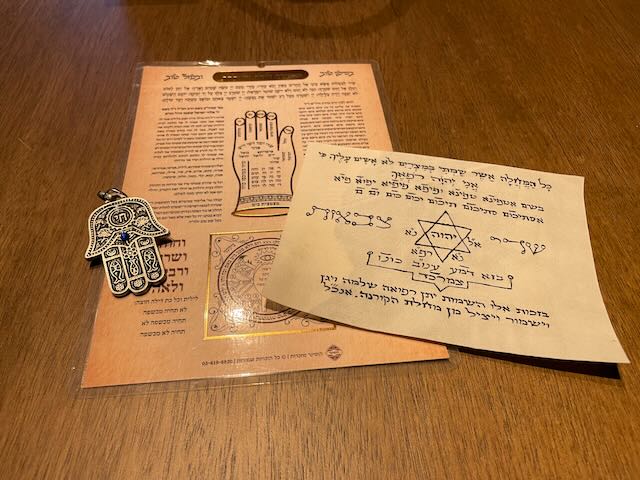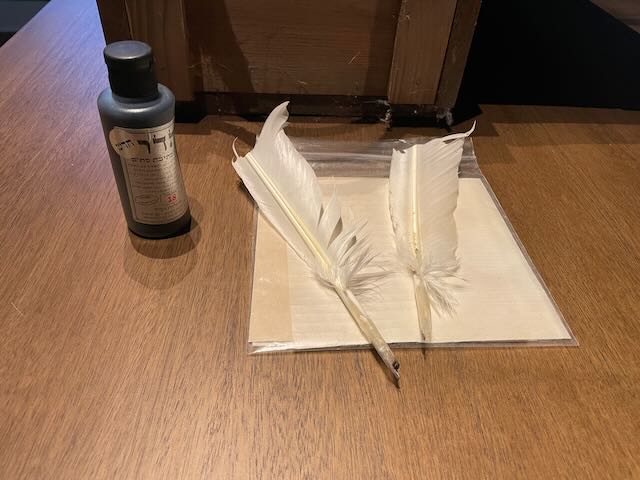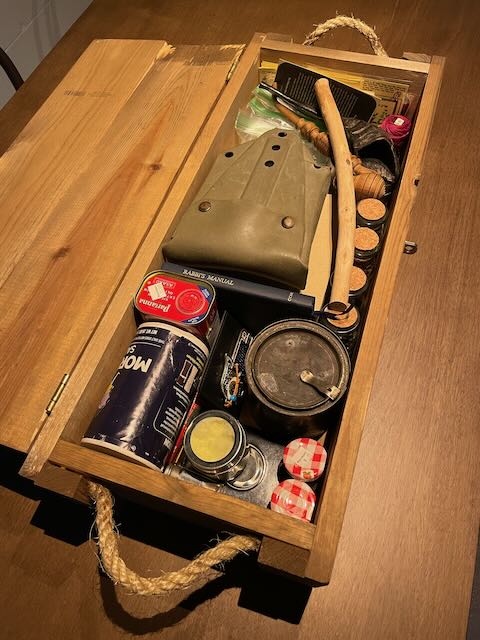Last night was Shabbat, one of the two nights (along with Tuesday), that Agrat bat Maḥlat, one of the queens of the shedim (aka demons), haunts the air with her train of eighteen myriads of messengers of destruction (1). With Havadalh behind me, I was out on patrol driving around in my beloved Honda Element loaded with all my Jewish monster hunting gear….ready for Agrat or whatever else might happen.
Actually I was home reading. Like usual. But my Jewish monster hunting gear boxes were ready to go. But what was in them?
Before I list out what I’ve collected so far, I want to point out that my gear collection is authentic if a bit eclectic. It draws draws from a range of Jewish sources and time periods, includes Ashkenazi, Sephardic, and Misrachi elements, mixes rabbinic and kabbalistic elements with elements from Jewish women’s segulot and prekante (Hebrew and Ladino terms for household charms) and Jewish medical lore. My goal is was to develop the gear that a modern ba’al shem (wonder rabbi) (2) or babske refuah (wise woman) (3) might have on hand. Just in case Agrat bat Maḥlat shows up or, more practically, I get to teach a class.
Part 1. Here’s a list of my original Jewish monster hunting gear.
In some cases I provide links on where to buy your own. These are just examples. I don’t have any financial relationship with the vendors. Please buy from small local business if you can.

- Hardwood ash. Sprinkle it on the floor to see shedim foot prints. (Brickhouse Acres or any soap making supplier)
- 2 small jars of jam. Shedim like jam. There are lots of reasons to be hospitable and get on speaking terms with shedim. (Cost Plus World Market or your any grocery store or farmers market)
- Salt. Shedim and ghosts don’t like salt and it can be used as a barrier.
- Iron pins. Traditionally, a Jew would wear an iron pin when traveling. Giving how much metal we carry with us these days wearing an iron pin isn’t really necessary..but it can’t hurt either. (Creating-Unkamen @ Etsy)
- Kero masa wood. According to the Talmud (Pesachim 111b), kero masa is harmful to shedim (4). Kero masa is sorbus, also known as the Serviceberry Tree. This stick is Latvian rowan wood, a kind of sorbus. (TrueWilderness @ Etsy)
- Shofar. Shedim can be scared by loud noises..so blowing a shofar is a go-to move. This is a cheap one I picked up on my one trip to Israel. Someday I’ll get a better one and learn to blow it properly. (Any local or online Judaica vendor)

- Candles. Beeswax are traditional, but any good quality ones are fine. (MrArtWood or any local farmers market, gift shot, or a zillion Etsy sellers)
- Oil. Good quality olive oil or similar. (Any grocery store, though I had to hunt around for oil in a transportable metal can.)
- Sulfur. Shedim hate strong smells including sulfur. (Pyro-build @ Etsy or any garden supplier)
- A card with text of Psalm 91, the Monster Hunter’s Psalm. Need to memorize this one or keep it handy.

- Amber incense. Shedim hate strong smells. Incense points back to the priestly koteret incense (Scents of Earth or a lot of Etsy sellers)
- Wooden pipe (for regular tobacco). Shedim hate strong smells but, more importantly, there is a tradition of rabbi’s smoking pipes with the mysitical intention of invoking the powers of the temple incense (koteret) to banish demons and plagues. (Any pipe will do. I like this walnut one. HousewarmingUA)

- Shmirah amulet (the big one with the upturned hand). Amulet to protect mother and baby from Lilith the demon queen. Amulets like this are hung in baby’s rooms and hospital delivery rooms. (Eichlers)
- Anti-COVID amulet. I picked this up on eBay from an Israeli seller. No idea who the scribe was or if it’s intended for the Charedi community or the tourist trade. Probably the latter, but it’s still cool. (eBay)
- Hamsa. Anti-evil eye charm. This one’s a cheap key chain. I have a couple of other ones but no really nice ones. (Nice vintage ones show up on eBay regularly. I’ll get one eventually.)

- A box of amulet making gear, including kosher torah ink, 5 kosher mezuzah klafs, 2 kosher quills, a metal scribal blade (for scratching out errors) and some replacement blades. – An experienced Ba’al Shem makes their own amulets. (A sofer supply store such as HaSofer)

- String. For tying up an estries hair. They lose their power when their hair is tied up.
- Rocks. Killing an estrie isn’t hard, but getting them to stay dead is. You nead to bury them with rocks in their mouths.
- Salt. If you hurt an estrie you can heal it by giving it your bread and salt.

- Army surplus shovel / entrenching tool. For digging a trench over a grave, in order to become willingly possessed by with an Ibbur (eBay)

Prayer books. Got to be ready for anything. I carry a vintage US Army Jewish prayerbook, a rabbi’s manual, and small “Prayers and Meditations” for funeral usage. Not in this picture, but I also have a couple of tahara manuals (preparation of the dead for burial).

- Shabbat kit. Portable Shabbat candle holders and matches case
- Havadala kit. Candle and candlholder, a collapsable wine glass (not pictured), and besamim. All of which have anti-demon properties, the besamim in particular.

I usually have some of my medical kit in my gear box as well. I’ll document my medical gear in another post, but I usually have lead and cloves on hand in case of the evil eye.
Notes and References
(1) Peasachim 112B.15 “With regard to the instruction: Do not go out alone at night, the Gemara states that this is as it was taught in a baraita: One should not go out alone at night, neither on Tuesday nights nor on Shabbat nights, i.e., Friday nights, becausethe demon Agrat, daughter of Maḥalat, she and 180,000 angels of destruction go out at these times. And as each and every one of them has permission to destroy by itself, they are all the more dangerous when they go forth together. The Gemara states: Initially, these demons were present every day. Once Agrat, daughter of Maḥalat, met Rabbi Ḥanina ben Dosa and said to him: Had they not announced about you in the Heavens: Be careful of Ḥanina and his Torah, I would have placed you in danger. He said to her: If I am considered important in Heaven, I decree upon you that you should never travel through inhabited places. She said to him: I beg you, leave me a little space. He left for her Shabbat nights and Tuesday nights. And furthermore, once Agrat, daughter of Maḥalat met Abaye and said to him: Had they not announced about you in the Heavens: Be careful of Naḥmani, Abaye, and his Torah, I would have placed you in danger. He said to her: If I am considered important in Heaven, I decree upon you that you should never pass through inhabited places. The Gemara asks: But we see that, notwithstanding these anecdotes, demons do pass through inhabited areas.”
(2) Ba’al Shem were, and in some places still are, Jewish healers, exorcists, and amulet makers. While not “monster hunter’s” per se, they are pretty darn close. See YIVO’s article Ba’al Shem, for an overview. Ba’al Shem could be formally elite rabbi’s or folks who pieced their knowledge together as they could. But they were guys. Ba’al shem is an Ashkenazi term, but there were Sephardic and Mizrachi equivalents.
(3) Babske Refues were, and still are, older women well versed in traditional home healing lore including exorcisms and protection from the evil eye. See YIVO’s article on Health and Healing. Again, I’m using a Yiddish term but am absolutely including Sephardic and Mizrachi equivalents.
(4) The text of Pesachim 111b reads “And any tree whose wood is hard, its shadow is dangerous, except for the tree called kero masa. Although its wood is hard, its shadow is not dangerous, as the demon said to her son: Leave the kero masa tree alone, as it was that tree that killed your father. And the tree later killed the son too. The kero masa tree is harmful to demon” Despite this claim, I’m not aware of any Jewish tradition that involves the practical use of kero masa to defend against demons. I figure it doesn’t hurt to keep a bit around, just in case.
